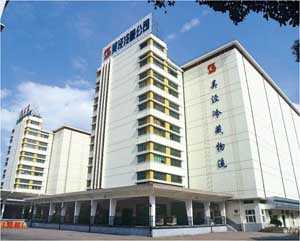
Many of the new cold storage facilities in China resemble tall office buildings, like this one in Shanghai that’s seven stories high. (Courtesy Keith Hu)
Though China’s lack of cold-chain facilities and logistics for perishable products has been its Achilles heel, improvements are expected within the next five years, says Keith Hu, Northwest Cherry Growers representative.
China is recognized as one of the hottest markets in the world due to its large population and potential for consumption. Many U.S. agricultural commodity groups, including apple growers, anticipate more open trading in the near future after trade talks in mid-January between the two countries. But is China ready to handle the influx of perishable produce?
Hu visited China last year to better understand China’s cold-chain challenges for cherries and other fresh produce.
Related story: “Big export year for Northwest cherries.”
China’s lack of cold storage facilities, refrigerated trucks, and retail refrigeration results in food contamination, food waste, and spoilage that limits the reach of most U.S. food products to the coastal cities, he reported during a Washington State Fruit Commission board meeting in December.
Hu noted that food safety is a growing problem in China, and numerous food safety incidents go unreported.
However, cold-chain improvements are being made. Government regulations effective in 2015 will require that 20 percent of fresh fruits and vegetables, 50 percent of meat, and 65 percent of seafood be handled through cold-chain channels, according to Hu. “This is a big milestone for them.”
During his visit, he toured ten cold-storage facilities, all similar in design and built like high-rise offices. Because space is limited in urban centers, most new cold storages are multi-story. One he saw in Shanghai was seven stories high. He observed significant growth in refrigerated warehouses, although total capacity still lags behind developed countries.
Hu noted that the United States had around 112 million cubic meters of refrigerated space in 2012. “India, with its 105 million cubic meters of refrigeration storage, has more than China’s 61 million cubic meters,” he said.
Most of the new cold storages are being built in cities, not near growing areas. He observed primitive transportation from farm to packing house or warehouse that involved using open trucks and placing baskets of produce on a bed of ice with a wet towel on top. China has around 70,000 refrigerated truck-trailer sets, compared to 245,000 truck-trailers produced in the United States in 2013, according to Hu.
“But China’s cold chain for perishables should improve in the next five years,” he said, adding that European companies are investing in China’s cold-chain infrastructure. Also, the Chinese government is encouraging construction of more cold chain facilities because of food safety issues.
“All of this should help U.S. industries in the near future to be able to reach new customers farther into China, past coastal cities and regions,” he said.






Leave A Comment